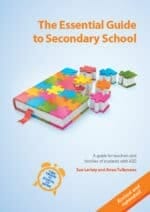 8 Key Strategies for Working with Families
8 Key Strategies for Working with Families
In my experience successful education for a child with ASD starts with a positive working relationship between home and school. One of the biggest challenges for parents/carers and teachers is to develop an effective relationship. It is in the interest of everyone involved – child, staff and families – that we create a positive partnership. This is created through teamwork, meetings, clear goals, regular communication and learning together.
When I looked back at who had attended my sessions I found a MISSING LINK! So few parents compared to teachers and teacher assistants. In 2016 I would love to see at my sessions ‘Dream Teams’: The Teacher, Teacher Assistant and Parents/Carers coming together for the overall benefit of the child with ASD.
“We are parents of 7 year old ASD boy. We have gone away with so much more knowledge and resources.” Olivia
8 Key Strategies for Working with Families
- Team work is the key to achieving desired outcomes. We are all on the same side. We all have the best interest of the child at heart. When we have the attitude that we are all on the same team, the child’s team we view everything differently.
- Share information, brainstorm ideas and learn together.
- Ask questions. You should never be ashamed to ask questions. We are all there to help the child through life.
- Brain storm ideas. Remember not every strategy works for every child so it is good to have a few ideas to try.
- Keep it real. Be brave and honest about the child and their requirements.
- Remember the child may act differently at home and at school.
- Respect each other! Be appreciative of each other’s efforts.
- Ensure the child and family develop a good relationship with the Principal. An informed Principal can support staff, student and families. They can be a good mediator when issues arise at school and find resolutions whether it is funding, behaviour or breakdown in communication. Principals tend to be constant in schools, whereas teachers can change each year. When the Principal is on side everything else will flow. Remember usually on a bad day the child gets sent to the Principal who needs to understand the child for this to be an effective strategy.
Excerpt from The Ultimate Guide to School and Home by Sue Larkey and Anna Tullemans, page 113.
Easy to Print Version of these Tips
8 Tips for Working With Families
FREE SHIPPING FOR THE ESSENTIAL GUIDE TO SECONDARY FINISHES March 6, 2016
Bonus Top 12 Tips to Set Up for Success in 2016
- Understand their difference (strengths and challenges), accept their different way of thinking, learning, socialising, etc .(Great reference to understanding ASD is Dr Tony Attwood’s books see website).
- Break it down. Break tasks down into smaller parts and give them each step sequentially. If possible, give them a checklist to mark off as they do each step. Do NOT expect the children to multitask! Allow them extra time to get it done, but let them finish! It is important to finish one task before going to another.
- Slow it down. Be aware of communication difficulties. Allow time to process verbal information, use visuals, and don’t overload them with verbal information.
- Use their special interests to motivate and engage – their strengths are motivated by their interest.
- Show them what is expected and what is happening, then they have less need to fight for control (i.e. schedules, routines, timers).
- Be careful how you use words, their literalness can mean they misunderstand you. Avoid words like ‘could’, ‘would’, ‘can’ as they perceive them as a choice. e.g. “Can you start work” can be seen as a choice.
- Use visuals to support learning: schedules, photos, pictures, Pics for PECS, timetables, highlight key information, mind maps, etc.
- Prepare by previewing. If possible ‘preview’ the learning ahead of time, to give a mental framework of what is being presented or what is next.
- Check in regularly – don’t wait for the student to ask for help – check in (learning, social and education).
- Computers and iPads are enabling for so many people with ASD, they can help build connections and confidence. (See tips for iPad’s on page 4).
- They find it hard to see things from other people’s perspective. This is known as ‘theory of mind’. They might also find it hard to understand and predict other people’s behaviour, and to understand how their behaviour affects others.
- They often find it hard to recognise facial expressions and the emotions behind them. They may miss facial cues from adults about behaviour, or social cues from peers.



 Sorry we no longer ship items outside Australia. Please consider the digital versions of Sue’s Books –
Sorry we no longer ship items outside Australia. Please consider the digital versions of Sue’s Books – 